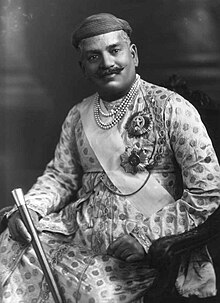Sayajirao Gaekwad
| Sayajirao Gaikwad | |
|---|---|
| Farzand-i-Khas-i-Daulat-i-Inglishia, Shrimant Maharaja Sir , Sena Khas Khel Shamsher Bahadur Maharaja Gaekwad of Baroda GCSI, GCIE, KIH | |

Sayajirao III Gaekwad, Maharaja of Baroda, 1919
|
|
| Reign | 10 April 1875 - 6 February 1939 |
| Successor | Pratap Singh Gaekwad |
| Born | 17 March 1863 |
| Died | 6 February 1939 (aged 75) |
| Consort | Chimnabai of Tanjore Lakshmibai Mohite |
| Issue | Shrimant Maharajkumari Bajubai Gaekwad Shrimant Maharajkumari Putlabai Gaekwad Yuvaraj Sahib Fatehsinhrao Gaekwad Shrimant Maharajkumar Jaisinghrao Gaekwad Shrimant Maharajkumar Shivajirao Gaekwad Maharani Indira Devi Shrimant Maharajkumar Dhairyashilrao Gaekwad |
| Dynasty | Gaekwad |
| Father | Kashirao Gaekwad |
| Religion | Hinduism |
Sir Sayajirao Gaekwad III (born Shrimant Gopalrao Gaekwad, 11 March 1863 – 6 February 1939) was the Maharaja of Baroda State from 1875 to 1939, and is notably remembered for reforming much of his state during his rule. He belonged to the royal Gaekwad dynasty of the Marathas which ruled most of present-day Gujarat.
Sayajirao was born in a Maratha family at Kavlana in Malegaon Tahsil Dist. Nashik as Shrimant Gopalrao Gaekwad, second son of Meherban Shrimant Kashirao Bhikajirao Dada Sahib Gaekwad (1832–1877) and Shrimant Akhand Soubhagyavati Ummabai Sahib. His branch of the Gaekwad dynasty was a cadet branch descended from a morganatic marriage of the first Raja of Baroda and so was not expected to succeed to the throne.
Following the death of Sir Khanderao Gaekwad (1828–1870), the popular Maharaja of Baroda, in 1870, it was expected that his brother, Malharrao (1831–1882), would succeed him. However, Malharrao had already proven himself to be of the vilest character and had been imprisoned earlier for conspiring to assassinate Khanderao. As Khanderao's widow, Maharani Jamnabai (1853–1898) was already pregnant with a posthumous child, the succession was delayed until the gender of the child could be proven. The child proved to be a daughter, and so upon her birth on 5 July 1871, Malharrao ascended the throne.
Malharrao spent money liberally, nearly emptying the Baroda coffers (he commissioned a pair of solid gold cannon and a carpet of pearls, among other expenses) and soon reports reached the Resident of Malharrao's gross tyranny and cruelty. Malharrao further attempted to cover up his deeds by poisoning the Resident with a compound of arsenic. By order of the Secretary of State for India, Lord Salisbury, Malharrao was deposed on 10 April 1875 and exiled to Madras, where he died in obscurity in 1882.
...
Wikipedia
